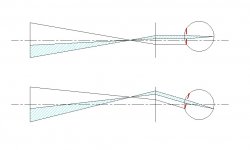This morning I did a couple of easy experiments with my Leica Trinovid BA, a normal glass binocular.
First I looked at a black telephone pole, with a bright sky in the background. Keeping my eyes centered behind the eyepieces, I moved the pole to the right side of the field, and yellow-green fringes appeared on the inner edge of the pole. Then, by moving my eye to the left, to recenter my eye on the now off-center exit pupil, I made the fringes disappear. By moving my eye even further to the left, occluding the other side of the exit pupil, I induced purple fringes on that same edge.
Second, with eyes centered, and left edge of pole centered, there were no fringes visible. But when I masked off the right side of an objective with my hand, purple fringes appeared, as predicted by Stokes for achromatic objectives.
I believe these tests demonstrate that much of the lateral color commonly seen in binoculars originates in the objectives, and is made visible by partial occlusion of the exit pupil due to eye placement. As part of the previous discussion, Henry Link tried Stokes's test with a Zeiss FL and got results quite different from what is expected with an achromat. I believe his result, and my results, taken with the frequently reported reduction in color aberrations in binoculars having ED glass objectives, supports the idea that ED objectives, at least when properly implemented as by Zeiss, are indeed the cat's pajamas, with regard not only to the subtle longitudinal, but also to the obvious lateral, color aberrations in binoculars.
I think as well that these tests largely exonerate the eyepieces from blame as the source of colored fringes.
Ron
Two days ago, I made a similar experiment with three binoculars on the full moon. The full moon makes the fringes more visible, and confirms the results I get in daytime.
The first binocular is the Fujinon 16x70 FMT SX2, that is known for its perceptible chromatic aberration in daytime.
When the lunar limb is centered, and the eye is perfectly centered, there is no trace of CA. But as soon as the eye moves to the right, there is a blue fringe that appears in the black sky at the left of the limb. When the eye is totally decentered, the blue fringe is very large and bright. The aspect of the fringe is very dependent on the eye position.
I agree this is a variation of the Stokes’ test.
The upper figure is an illustration of this situation. Here the eye is decentred to the top. Only the edge of the objective is used to form the image, and unfortunately, this is the worst part for chromatic aberration.
Then I put the lunar limb off axis. Again, I saw a large and bright fringe, very similar to the previous one. This situation is illustrated in the lower figure : in order to see the off-axis image, the eye must rotate in its orbit, in this causes exactly the same vignetting as previously. Again, the aspect of this fringe is very sensitive to eye placement.
In this case, what we call lateral CA seems to be due mainly to the objective.
The second binocular is the Zeiss 15x60 BGAT. When the lunar limb is on axis, moving the eyes creates a purple fringe. Compared to the Fujinon, the fringe is much fainter and narrower. Obviously, Zeiss could have been promoted extra-ED-super-APO objectives for these binoculars

.
When the moon is off axis however, the fringe is totally different : there is a very narrow and intense red fringe, that seems to be less sensitive to eye placement. Maybe this is the true lateral CA due to the eyepiece, that is visible only because there is very few longitudinal CA.
The third binocular is the Nikon SE 12x50. On axis, the behaviour is very similar to the Fujinon 16x70 : a blue fringe sensitive to eye placement, but fainter and narrower than in the Fujinon. But compared to the purple fringe in the Zeiss, this blue fringe is more prominent. It’s quite an achievement for the Zeiss considering its higher magnification and larger objectives !
Off-axis, there is a narrow and intense red fringe, that seems almost identical to the Zeiss. Here also, I believe this could be the lateral CA due to the eyepiece.
The most interesting, is that moving the eye is this situation creates a blue fringe, wider and fainter than the red fringe, that reminds me of the blue fringe on axis. The red fringe remains visible near the limb.
My interpretation is that off axis, I can see in the same time the true lateral CA of the binocular as a rather constant red fringe, and the longitudinal CA as a variable blue fringe.
All these observations should be confirmed with my other binoculars and other experiments with a booster. I don’t consider they are definite conclusions. But basically, I agree with Ron’s comments, even if the subjet is complex.
Jean-Charles






